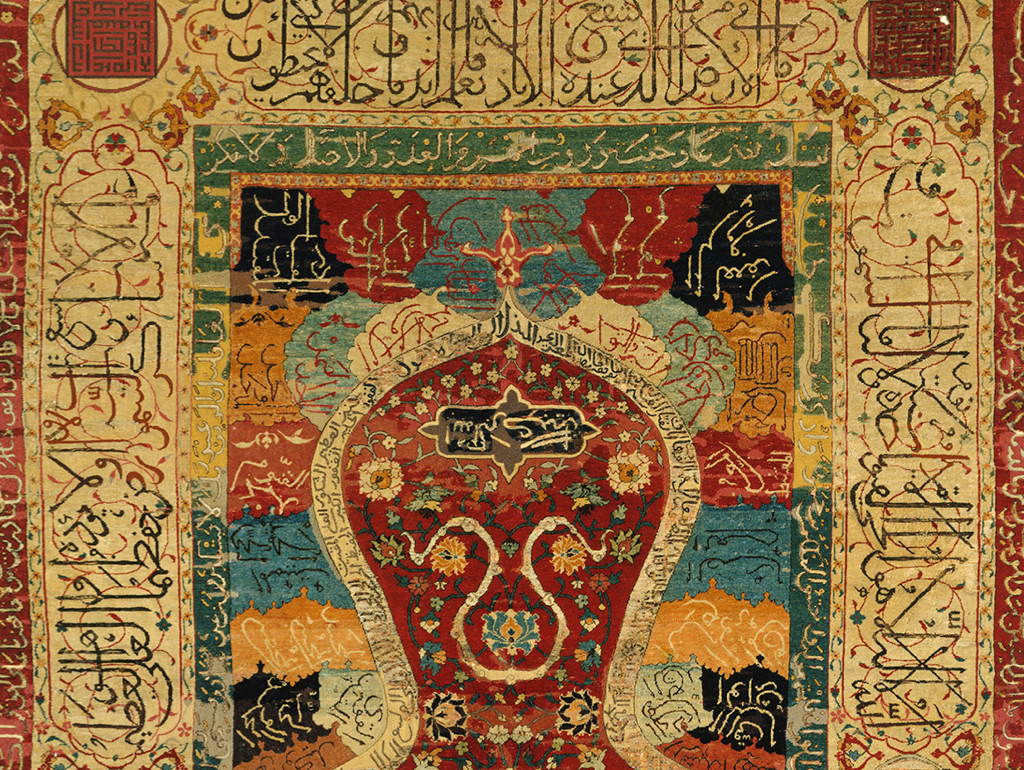MEDIA CONTACTS:
Chita Middleton: chita gwu [dot] edu, 202-994-5593
gwu [dot] edu, 202-994-5593
Caitlin Douglass: cdouglass gwu [dot] edu, 202-994-6460
gwu [dot] edu, 202-994-6460
WASHINGTON (January 5, 2023)—The exhibition Prayer and Transcendence introduces visitors to the purpose and iconography of prayer carpets from across the Islamic world, as well as design comparisons from the Jewish tradition. On view from February 18 through July 1, 2023, some 20 carpets spanning the 16th through 19th centuries are drawn from five collections – The Textile Museum Collection, Harvard Art Museums, Cincinnati Art Museum, the Metropolitan Museum of Art and the Markarian Collection.
"By presenting the iconography of prayer carpets and its interpretation across time and artistic traditions, from Ottoman Türkiye to Safavid Iran to Mughal India, Prayer and Transcendence can deepen our understanding of these textiles as a unifying element of Muslim cultures on our campus and around the world," said John Wetenhall, director, The George Washington University Museum and The Textile Museum.
"These textiles have played a critical role in creating, defining and enhancing religious spaces — and their designs have connected cultures across time and place," said Sumru Belger Krody, senior curator, The Textile Museum Collection. "Imagery of an arch, flowers and a mosque lamp transforms a prayer carpet from a simple textile into the embodiment of holy space — a link between the earthly and transcendental realms where worshippers can commune with God."
The distinctive iconography of prayer carpets has been developed over centuries and circulated through trade and religious pilgrimage (hajj). Carpets on display from Türkiye, the Caucasus, Iran, Central Asia and India all share a central motif: an elegant arch surrounded by vegetation and flowers. One of the most iconic images in a prayer carpet, the arch often symbolizes the gateway to paradise, conceived in the Koran as a lush, walled garden.
The exhibition will also explore the spiritual meaning of the lamp and water pitcher motifs that recur throughout prayer carpet design. Worshippers use water from a pitcher, or from a fountain in the mosque courtyard, to cleanse both body and spirit before they pray. In the mosque, a hanging lamp symbolizes the divine presence. Two Jewish Torah Ark curtains on view employ a similar artistic representation of a lamp as a symbol of divine light, and the arch as the entrance to paradise.
Support for this exhibition and related programming is provided by Aramco Americas, the Bruce P. and Olive W. Baganz Fund for The Textile Museum Exhibitions and Publications, the David Berg Foundation, E. Rhodes and Leona B. Carpenter Foundation, and the Markarian Foundation. Additional support is provided by Tina M. deVries, Helen K. King, Mary Jo Otsea and Richard H. Brown, Roger and Claire Pratt, and David M. Sloan.
Prayer and Transcendence runs roughly concurrent with Anne Lindberg: what color is divine light?, a site-specific and immersive installation on the museum's third floor that will transform light and thread into a site for contemplation and reflection from February 4 through July 1, 2023. The museum will offer a program for visitors to engage with each other in an interfaith dialogue, and visitors may also discover connections between the historical prayer carpets and Anne Lindberg’s installation on their own.
The George Washington University Museum and The Textile Museum is located on GW’s Foggy Bottom campus at 701 21st Street, NW, in Washington, D.C., just blocks away from the Smithsonian Renwick Gallery, the White House, Kennedy Center and the National Mall. Galleries are open to the public Tuesday through Saturday from 10 a.m. to 5 p.m. Admission to the museum is free.
For the most up-to-date information on the museum's visiting hours, exhibitions and educational programs please check the museum website.
Guided tours, as well as virtual and in-person programs, some listed here, explore themes from the exhibition and installation. Browse upcoming programs.
Interfaith Reflection and Dialogue on Divine Light
Thursday, February 23, 7 p.m.
(In person)
Following a tour of the exhibition Prayer and Transcendence, participants will engage in an interfaith dialogue in the galleries led by the Interfaith Council of Metropolitan Washington. The conversation will take place among Anne Lindberg's site-specific installation what color is divine light?
Register online
Prayer Carpets Colloquium
Tuesday, March 21, 10 a.m.-12:30 p.m.
Wednesday, March 22, 10 a.m.-12:30 p.m.
(Virtual)
This event will bring into conversation scholars and other leading voices from across the globe. Held in conjunction with Prayer and Transcendence, the colloquium is designed to enrich the scholarly contributions of the exhibition. Panelists on the first day will explore prayer carpets in context, with a discussion of the divine interpretation of these works following on the second day. This program is a partnership with the Vehbi Koç Foundation's Sadberk Hanım Museum.
Register online
Gallery Tours
For in-person gallery tours led by experienced docents for a group of up to 20 people, submit an online request at least three weeks in advance.
-GW-


